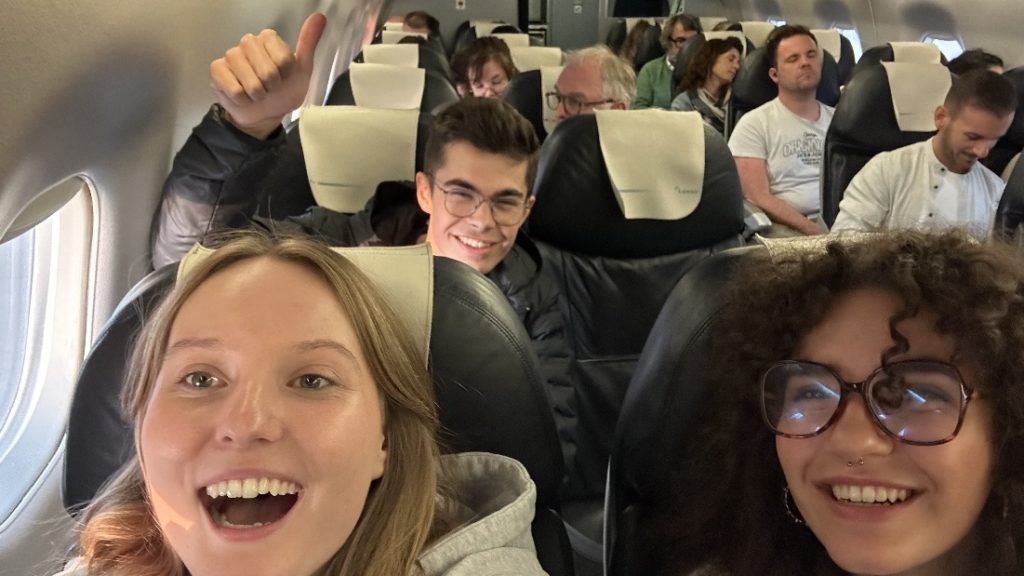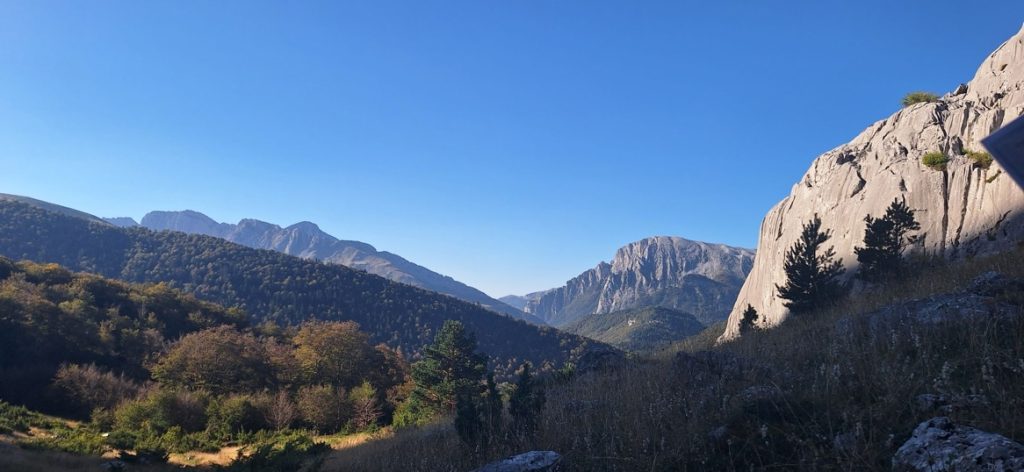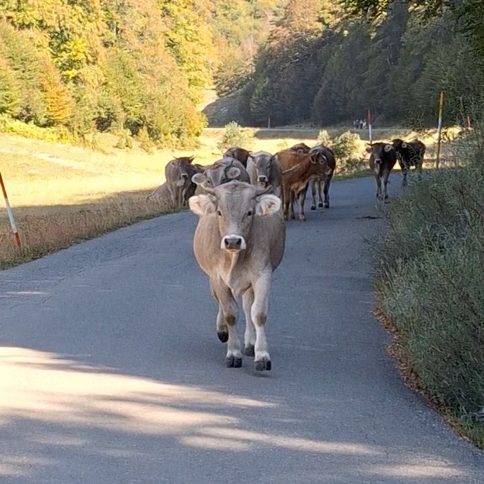Sitz Amélie, Neu Arend Alexis, Barth Tom, Back Morgane, Safavi Calista
30th September – 6th October
The project « Wanderlust » is an educational excursion which unites 6 countries from Europe: Spain, Germany, Belgium, Slovakia, Poland and Luxembourg. At first students stayed with host families in Zaragoza. Then they travelled to Linza, a unique spot in the heart of the Pyrenees in Huesca, in the northwestern region of Aragon. The main goal of Wanderlust is the reflection about human relationship with his environment through the generation of aesthetic links with nature. Different activities such as hiking, climbing a rock wall, practicing yoga in the prairie and listening to the sounds of nature and philosophical workshops will help the participants feel their connection with nature. Each country got a pre-task to reflect on.

We, students form Luxembourg, arrived Saturday in Zaragoza, where our hosts welcomed us. For everyone of us (Morgane, Amelie, Tom, Alexis, Calista) it was our first time staying at somebody’s else’s house. After sharing our feelings about it, we can say that we were quite nervous at first, but quickly felt included and enjoyed this new experience. On the mornings we would stay with our hosts and do activities with them like going to the city centre, go on a walk, chill out…. In the afternoons we would get together with all the hosts and meet up with the other countries.

On Saturday, we went on a walk through the city of Zaragoza and our hosts showed us the “Basilica de Nuestra Senora del Pilar”, which is one of the main touristic attractions in Zaragoza.
The day after, we got to visit the aquarium of Zaragoza where we saw big fishes, as well as other animals.
On Monday, we went to school with our hosts. After this, the teachers from the Miguel Catalan school showed us the economic and environmental projects they have in Zaragoza. In the context of the extremely hot summer, we learnt about the importance of green spaces in big cities.
Later this day we went kayaking through Ebro River with the students from the other countries and learnt about flood-risk management.

Tuesday 3rd October:
After arrival by bus and a delicious lunch at the mountain resort in Linza, we began having eco-dialogues in the afternoon. Each teacher from the respective countries had received a “Station” to prepare and then present to each group formed during the afternoon. Each group was composed by at least one pupil of each country to ensure diverse dialogues about different topics during the stations. In total there were 4 stations; Station 1 consisted of talking about Nature and Aesthetics: The beauty and the sublime; the second station revolved about Nature, Literature, Ethics and Politics: Thoreau and the transcendentalists; the third station tackled the issue of Unspoiled vs. Transformed Nature: Technique and Art; and finally the last station was about Wanderlust: walking through the wilderness.
Every 30 minutes, the groups were sent to the next station in order to create a certain work dynamic and make the dialogues more interesting and reinforce our debating skills. At the stations themselves, the pupils received the text being discussed and one pupil of the Spanish group created a “mind map” that regrouped relevant ideas during the dialogues from all the different groups in order to have 4 mind maps in total. Afterwards when every group has had an eco-dialogue with each station, we had a plenary discussion about the topics presented in the stations and each « mind map” was presented to reinforce our main ideas creatively crafted by each group passing the respective stations.
Station 1: Nature and Aesthetics: The beauty and the sublime
The first statement discussed was “Is nature beautiful because we like it or do we like it because it is beautiful?”
At first nobody responded and everyone took a second to think about the statement which is clearly philosophically challenging. The first few pupils started to state their opinions on how each individual perceives beauty in different elements. We like nature because we are nature was the final statement of my group. Since we are biologically made from nature, we are made out of one of the four earth elements, water. We cannot think that nature is “ugly” because each individual perceives “ugliness” and “beauty” in a different way but when it comes to nature the majority agrees to find beauty in it. In nature we feel emotions, we feel a connection and mostly a sense of freedom. Moments when nature feels like magic such as during sunsets, sunrises or stargazing makes an individual appreciate the moment for its simplicity. In that moment we feel a sense of infinity and gratitude towards the beauty of a certain moment that only nature can provide. So beauty lies deep within nature and we appreciate and respect it because we like to find the beauty in it.
The second statement was “Can we be taught to perceive beauty of nature ? Can the aesthetics be educated?”
This statement brought a lot of controversy with itself because pupils coming from different countries, all have different relationships to nature and its beauty.
It was very interesting debating together and crafting ideas to answer this question without disrespecting any point of view. In the end we came to a final agreement that aesthetics can be educated to a certain extent and that the perception of beauty in nature comes down to each of their personal connections with nature depending on where they live and how their childhood memories encorporating nature is.
Station 2 : Nature, Literature, Ethics and Politics: Thoreau and the transcendentalists
The first question asked by the teacher was “What does Nature mean for you? Do you feel part of it or do you see it as something external, material, a setting where events take place” almost all the pupils agreed to feel a certain connection between them and nature. We were able to express a moment where the bond felt very strong such as during our childhood or while walking our dog during autumn season in a beautiful setting like a forest. The teacher then proceeded to educate us about the philosopher Thoreau and his lifestyle, it was very interesting to interact with different teachers from foreign countries and notice their teaching style vary.
The term “transcendentalist” was brought up, they were American thinkers of the 19th century and believed in the inherent goodness of people, the importance of self-reliance and felt a deep spiritual connection with nature as paths to higher understanding and truth. The transcendentalists were discussed throughout the whole philosophical essay and were brought in connection with the philosopher Thoreau.
The second statement was “Do you agree with the thoughts of degrowth movement? Is there an alternative to degrowth” during this conversation the terms “van-life”, “minimalistic lifestyle” and “downsizing” were brought up frequently. We then asked ourselves if we personally would live a “van-life” or a “minimalistic lifestyle” and lots of pupils agreed to liking the idea of not having a permanent home location but mostly during their twenties. Afterwards some pupils expressed their personal opinion on downsizing and its pros and contras. Finally one of the Spanish students wrote down all our ideas on the mind map and we proceeded to switch stations!
Station 3: Unspoiled nature vs transformed nature
The third station was about man’s interaction with nature. We dealt quite intensively with the question of how a technically highly modern humankind could live in harmony with nature. There are lots of concepts for this, be it living on the sea or in hills. The fact is, civilisation has now reached every corner of the earth and nature is being permanently changed by mankind. The third station was also about the connection between art and nature. In the 1970s, it became a trend to turn nature into art. Spirals in particular have become a very popular model for art.
Station 4: The desire to walk
The fourth station is about the desire to walk, the desire to get into nature. For a long time, hiking was not seen as an occupation, but rather as a necessity to survive. This then changed with Romanticism, an artistic era in which nature was one of the central themes. Since then, many people seem to love to escape civilisation by hiking. We have concluded that hiking promotes reflection. While hiking, one can easily reflect on one’s own life, which is often no longer possible in today’s world. We have found for ourselves that hiking gives us the freedom that civilisation cannot give us. It almost seems that we can only really discover ourselves as human beings in nature. Nature simply gives you a clarity that you cannot otherwise achieve in life. However, we have also found out that the motives for hiking differ from person to person. Everyone feels differently about nature and hiking, everyone has a different relationship to it.
The hike to Petrechema Peak
The second day of Wanderlust was the day we climbed the Petrechema Peak.
On this day, we woke up early and set out after a quick lunch, ready for our hike to Petrechema Peak, which is located in the heart of the Pyreneen Mountain range, bordering Spain and France. We tackled the challenging slopes with determination, although they did push our endurance. The Pyrenees, unlike the familiar Alps, showcased a rugged, untamed beauty that felt refreshing and raw.
During our climb, we encountered some cows and wild horses, guided by their shepherd. It was a reminder of the delicate balance between humans and nature, a sight that left a lasting impression. Unfortunately, not everybody got to enjoy Petrechema Peak as the 12,000 height meters posed too great a challenge for some.
As we climbed higher, the connection to nature deepened. The vast mountains made us feel small in comparison, emphasizing the incredible power of the natural world. Three hours of continuous hiking brought us to the summit of Petrechema Peak, standing proudly at an elevation of 2,336 meters (7,664 feet) above sea level.
The view from Petrechema Peak was remarkable – endless peaks and valleys were visible and showcased nature’s size. The experience not only tested our physical limits but also created a profound appreciation for the unspoiled wonders of the natural world.
Orientation Hike:
On the last day in the Pyrenees, before we went back to Zaragoza, we did an orientation hike in the morning. Most of us had our sports clothes and hiking boots on, as it was usually still a bit damp and therefore slippery in the morning. First, we were told the goal of the hike, as it was not only about finding the right way, but a little to the right or left of the path, small lanterns were hung up with staplers attached to them and we should find all of them. One of the teachers had taken the fun of explaining to us how best to defend ourselves in case a bear attacked us, but after seeing the frightened faces, he had explained that there were no bears in our region. After that, we were called into groups with a 5-minute difference, had to think of a group name, were given a map of the trail and sent off.

Everyone was tired from the previous day’s hike and we were told that the trail was very straight. What is very ironic about it is that it is very steep uphill for the first 10-15 minutes. Due to the fact that there was only a 5 minute difference between the groups, 4 groups had met at the top of this hill as we all needed a bit of a break. We then walked on together. It was a good time going down which was good for everyone and you had a beautiful view of the mountains around you in that time. As always, once it goes down, it has to go up again, and so it happened that the path became steeper again but more pleasant this time. There wasn’t actually a laid path for the first half of the trail, but we walked on footpaths.

After a certain point, the path went up and up and when we came around a corner, we saw a huge flock of sheep a little higher up in the mountains. The animals in the Pyrenees all wear bells around their necks, so we not only had a beautiful view, but also a bell concert. After the sheep, we took a very narrow path into the forest. The 3 of us also met our teacher Mr. Brücher. Deeper into the forest, the path suddenly descended dangerously steeply and to the left it went down metres. By sliding and holding on to trees, we all made it to the bottom, where a beautiful spring was waiting for us. The water runs down stones from above into the spring, which was not only a beautiful sight, but also made a splashing sound.

After that, the second part of the hike started, where the promised straight part also started. It was very relaxing and we all started talking again. To the right of us flowed the small spring that has become a small watercourse and we were still in the forest. The path was long and descended slowly and steadily. When we arrived in the valley we were five groups and 4 of us had found each other. Together we walked along the valley when suddenly a herd of cows came towards us. The first cows passed us relaxed, but the fourth one stopped fearfully. We got scared too and went a bit off the path and looked for some cover along a small path that went down. The cows started to run past us, which was very impressive but also very scary. After that it was not long and we only had to walk another 10 minutes to get back to our hut and eat our last lunch and then head back to Zaragoza. It was a beautiful hike and with all these people it was even more fun.
Conclusion:
We are all so happy that we had the possibility to participate in such an incredible program. We met lots of new people from different countries which allowed us to get to know new cultures. This educational journey showed us the importance of nature in life. We realized that nature has a big impact on us. Even in bad times, nature can give you a smile like it gave one to us.